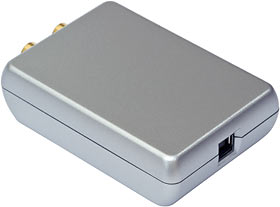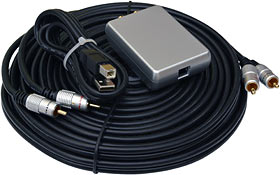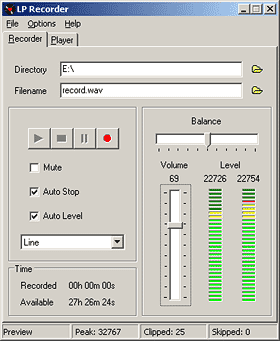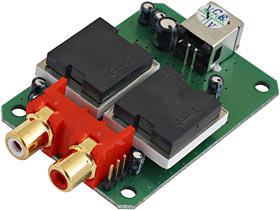
Xitel INport
Review date: 23 September 2003.Last modified 03-Dec-2011.
PC audio hardware these days is, for most purposes, very good. Any dirt cheap sound card gives you high enough output quality for music listening, and these days they usually also support 3D positional audio and other frills. The audio hardware built into many motherboards these days is fine, too. More and more entry-level audio adapters are even sprouting multiple outputs for surround, and digital outputs and inputs.
Sure, there's often a bit of interference hash in the background of the output from consumer audio adapters, but most people don't mind it. You're only likely to be able to hear the noise at all during very quiet passages of music. If you hear lots of computer-noise through your speakers, then it's probably the speakers that're picking up the RF noise of the computer, not the sound card.
Input, though, is a different matter.
Practically all audio adapters have an input jack, and everything vaguely modern can cut the mustard perfectly well for Internet telephony, voice chat in games, and often even genuine music recording. If you want a really good line in connector on your PC, though - so you can make clean CD and/or MP3 copies of old tapes, LPs, wax cylinders or what have you - an ordinary consumer sound card is unlikely to give you the heirloom-quality results you're looking for.
Enter Xitel.
Xitel have made a name for themselves by selling a small range of polished, well-presented USB audio devices for reasonable prices. Yes, you can get cheap USB sound gadgets from all kinds of places, and they'll probably work OK - but Xitel's hardware looks great, is genuinely technically superior to most of the generic beige plastic gear, and isn't ludicrously expensive, when you consider what you get.
The INport is a typically slick-and-simple Xitel product. Connect it to a USB port on a Windows 98SE or later PC, and it gives you one new line in, via a pair of RCA jacks.
It lists for $US69.95, or about $AU139.95 here in Australia.
For your money, you get the INport box itself, and a USB cable, and a great big high quality 30 foot RCA-to-RCA lead for connecting the INport to your stereo. This is an excellent inclusion. You don't have to use the long cable if you've got a suitable shorter one and it's no trouble for you to put the sound source near the computer, but if you need to run a wire to the next room, this big blighter will make things easier.
The cable also ought not to harm the sound much in transit. 30 feet is a fair bit of cable to run line level audio down, but this lead's got quality connectors and beefy conductors.
It ain't Monster Cable, but to my mind that's an advantage. At least some cable manufacturers have the decency to label their wire appropriately.
The bundle also contains a USB cable, of course, and a software CD.
The CD doesn't contain any drivers, because every version of Windows from 98SE onwards should be able to recognise the INport natively using the drivers the OS comes with. Instead, you get a good manual (in PDF format), and a couple of CFB Software applications - LP Recorder and LP Ripper. These two apps don't have a lot of features, but that's a feature in itself; they make the tape/LP/whatever capture process as simple and streamlined as it's likely to get.
Using it
Hooking up the INport to a PC is dead easy; connecting it to your stereo is almost as simple. Anything with a line level output (or headphone level, if you've got a 'phone-to-RCA adapter lead) should work fine with the INport, but you can't connect it directly to a record player unless you've got one of the rare turntables with an integrated pre-amplifier.
If you've got a turntable, of course, then you've probably got a pre-amplifier or integrated amp with phono input, which takes care of the pre-amplification and equalisation. The INport connects to a record output from that device.
Now, it's LP Recorder time. You can use the INport as an input for any sound software you like, but LP Recorder is perfectly fine for the simple basic tasks that most people want to do. It lets you select input and output devices, it records audio to a file, and it can automatically stop when it hasn't heard anything for a while.
LP Recorder also has an Auto Level feature, which makes it easy to set the record gain setting properly, so you don't waste dynamic range by recording too quietly, or create horrible distortion by recording too loud. Auto Level simply turns down the gain when the input clips. It's not retroactive; there's nothing it can do to magically get rid of clipping distortion once it's happened. But if you feed LP Recorder the loudest passage you're going to record before you actually start recording (you can use Auto Level both before and after you click the record button), it can get the gain right with no effort from you.
LP Recorder spits out 44.1kHz, 16 bit stereo WAV files - CD audio quality - which is what most users are going to want to use all the time. The INport's hardware seems to be perfectly happy delivering other sample rates, though; 48kHz worked when I tried it with other software.
LP Ripper is another straightforward program; it's for splitting your single-file analogue recordings into tracks. If the recording has well-defined quiet spots between songs or movements or whatever, and no other quiet spots, then all you have to do is tell LP Ripper how many tracks there are and it'll pick the split points perfectly well itself.
If it's not that easy to pick the splits then you'll have to do it yourself, but LP Ripper makes the task easy enough. It can play you clips of the beginning and end of the tracks, it lets you adjust track length coarsely or finely via mouse clicking and by just typing in numbers, and you can also fade tracks in and out.
When you're done, LP Ripper spits out a separate WAV for each track, with whatever name you entered - they'll default to all having the name of the source file plus a number.
This is where the functionality of the INport package stops, though, which is somewhat disappointing. I would have liked to have seen at least a basic "audio restoration" package as well, to help deal with clicks, pops, rumble, hiss and so on from old analogue recordings. It's important to have an intermediate cleanup stage when transferring practically all old recordings to digital. But if you want to do that with the INport, you're going to have to use some other software.
The INport bundle also lacks anything to let you burn audio CDs or create MP3s or WMAs or OGGs or whatever. This isn't much of a problem, though.
These days, it's pretty much impossible to buy a cheap CD burner that doesn't come with Nero or some similarly competent burning software, and free encoding software is similarly easy to find. So it's no big deal that the INport bundle doesn't do this. It'd be nice if there were a click-and-go encoder/burner package included as well, particularly since the INport is otherwise eminently suitable for non-tech-savvy users, but it's not a serious flaw.
Looking inside
The little INport box weighs about 81 grams (2.9 ounces), which is more than you'd expect for a mere plastic enclosure with a circuit board in it.
Here's the reason. Two (relatively) weighty isolation transformers sit between the input signal and the INport's A-to-D hardware, to provide ground loop isolation.
This is a big plus, and worth money. Ground loops are common when people connect audio devices together; when shielded cables connect devices whose ground planes are at different potentials, current flows in the cable shield and the result is often an annoying hum.
Use an INport as your line in, and this problem won't arise.
(Jaycar Electronics have a good PDF-format primer on this subject here, by the way. Xitel also sell a separate isolator box for use with other gear.)
The other side of the circuit board contains the brains of the operation - a Sonix SN11113 USB audio controller (PDF datasheet here), and a Via VT1612A audio codec. These two chips aren't being fully utilised in a device that provides just one input and no outputs, but they're not exactly million dollar components, so that's OK.
Overall
The INport performs as advertised, and is well priced, for what you get.
If you want to do real pro audio work with a PC, then you'll want a proper multi-input sound card. Likewise, if you want to do heavy-duty editing, you'll need one or another of the full-featured sound workshop packages out there.
If you just want to add a high quality analogue audio input to pretty much any vaguely recent Windows PC or laptop, though, the INport gets the job done as quickly and easily as possible (you'll still have to flip your own records, I'm afraid). And it won't leave you hunting down a hum problem, either.
It'd be good if there were a sound restoration package included as well, but I still like the INport a lot. Recommended.
Review INport kindly provided by Xitel.







